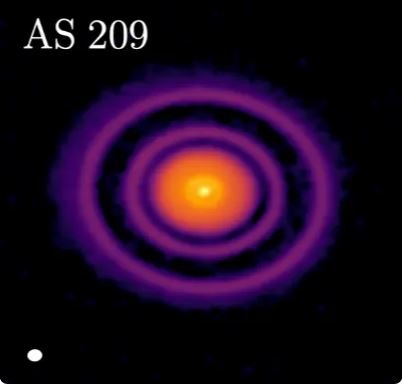According to NASA, there are more than 5,000 planets that exist outside the Solar System. This week, astronomers announced that they may have discovered the youngest planet to date.
The transcendental astronomical observation system ALMA has made an extremely unusual discovery: A truly “newborn” planet in the dusty disk of the young star AS 209.
The latest planet discovery was published by scientists in The Astrophysical Journal Letters.
Scientists used the ALMA observatory in Chile to detect gas in the planetary disk, the collection of dust and debris found around young planets.
According to the US National Radio Astronomy – a unit that cooperates with ALMA, this discovery indicates the presence of a very young exoplanet. An exoplanet is a planet found outside the Solar System.
Specifically, when studying AS 209 – a young star 395 light-years from Earth in the constellation Ophiuchus – astronomers observed “a blip emanating in the middle of a void in the surrounding gas.” star”. This led to the discovery of a planetary disk surrounding a potential planet with the mass of Jupiter.
AS 209 is a young star in the constellation Ophiuchus, identified by scientists as possibly containing one of the youngest exoplanets ever. The star still has a protoplanetary disk – purple rings of gas and dust – AS 209 – Photo: ALMA
Researchers are closely monitoring the new planet, which is located about 29.9 billion kilometers from its host star. This distance is considered by astronomers to challenge the currently accepted theories of planet formation.
“And if the host star’s estimated age of only 1.6 million years is correct, then this exoplanet could be one of the youngest planets ever discovered,” notes the National Radio Astronomy Observatory. .
According to the agency, the new observations at AS 209 could shed more light on the evolution of the planet’s atmosphere and the processes by which moons are formed.
This star system has also been of interest to scientists for more than 5 years because of the presence of 7 interlocking rings. Researchers believe this has something to do with planet formation.
Scientists note that more research is needed to confirm the existence of this new planet. Astrophysicists hope upcoming observations with the James Webb Space Telescope will confirm the presence of the new planet.
“The best way to study planet formation is to observe planets as they are forming. We live in a very wonderful time when this is possible thanks to powerful telescopes like ALMA and James Webb,” said Jaehan Bae, a professor of astronomy at the University of Florida and lead author of the study. articles, reviews.
Source: Hai Anh of laodong.vn









